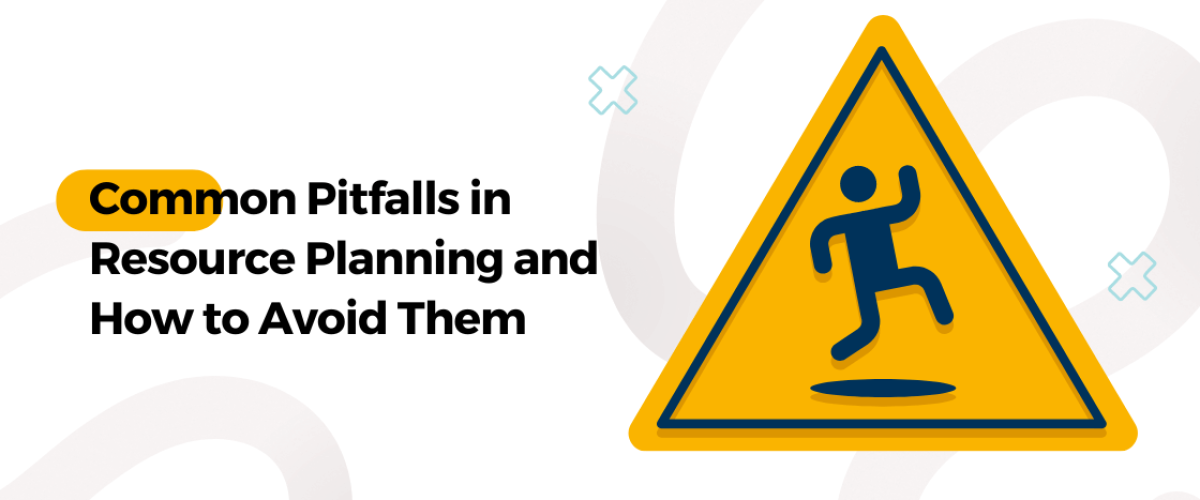Good resource planning is important for making projects successful. If you don’t plan well, even the best projects can have problems like running out of resources, going over budget, or being delayed in delivery. In this guide, we will discuss the common mistakes people make in resource planning and give useful tips to avoid these problems.

1. Poor Resource Assessment
Description
Not checking resources properly means you don’t fully figure out what you need for a project. This can cause big problems, like underestimating what’s needed and causing delays.
Common Signs
- Unexpected Delays: Tasks take longer than expected because you didn’t have enough resources.
- Budget Overruns: You spend more money than planned because you didn’t estimate resource needs accurately.
How to Avoid
- Do a Detailed Resource Check: Start by making a complete list of all the resources you’ll need for each part of the project. This includes people, tools, technology, and materials.
- Use Past Data and Industry Examples: Look at information from previous projects and industry standards to help with your planning. Past data can show you what resources you might need and common problems.
- Include Team Members: Ask your team for their input on what resources are needed. Their experience with similar tasks can give you useful ideas on what you’ll actually need.
2. Communication Gap
Description
When team members and stakeholders don’t communicate well, it can lead to misunderstandings, mixed-up goals, and project delays.
Common Signs
- Confusion Among Team Members: Team members aren’t sure about their tasks or what resources they have, causing problems with their work.
- Misaligned Project Objectives: Stakeholders and team members have different ideas about what the project goals are and what resources are needed.
How to Avoid
- Hold Regular Meetings: Have regular meetings to talk about resource use, project progress, and any new issues. This helps everyone stay on the same page.
- Use Collaboration Tools: Use tools like KolApp, Slack, or Microsoft Teams, to help team members communicate and work together in real time.
- Create Feedback Channels: Set up ways for team members to give feedback or report problems. Make sure there’s a system to handle these concerns quickly.
3. Ignoring Resource Limits
Description
If you don’t pay attention to limits like budget or the number of people available, it can mess up your project and cause big problems.
Common Signs
- Project Delays: Tasks get postponed or slow down because you don’t have the resources you expected.
- Budget Overruns: You spend more money than planned because you didn’t account for the limits on resources.
How to Avoid
- Set Realistic Goals: Match your project goals with the resources you have. Make sure you consider the real budget, time, and people available.
- Make Backup Plans: Prepare for resource limits by having backup plans. This might include finding other resources or changing the project timeline.
- Check and Update Plans Often: Keep an eye on resource availability and update your plans as needed to stay on track.
4. Lack of Flexibility
Description
If you can’t adapt to changes or unexpected problems, your project might fail and miss deadlines or goals.
Common Signs
- Struggling with New Information: The project has trouble using new information or requirements, which causes delays.
- Delays from Unexpected Problems: New problems come up, and the project can’t adjust quickly enough to fix them.
How to Avoid
- Make Flexible Plans: Create resource plans that can adjust to changes. This could mean having flexible timelines or being able to change how resources are used.
- Keep an Eye on Progress: Regularly check on how the project is going and how resources are being used to spot any problems early.
- Encourage Adaptability: Help your team see changes as chances to improve, not just problems. This way, they’ll be better at handling changes.
5. Incorrect Forecasting
Description
If you guess wrong about how many resources you need, you might end up with too few or too many. This can mess up your project’s timeline, budget, and efficiency.
Common Signs
- Mismatch Between Planned and Actual Needs: The resources you planned for don’t match what you actually need, causing problems.
- Resource Shortages or Surpluses: Unexpectedly running out of resources or having too many can disrupt the project and increase costs.
How to Avoid
- Use Advanced Forecasting Tools: Tools like KolApp, Microsoft Project, or other forecasting software can help predict your future resource needs more accurately.
- Update Forecasts Regularly: Keep your forecasts current by using the latest information about the project and resources.
- Include Key People in Forecasting: Get input from important people involved in the project to make your forecasts more accurate.
You might also like this: Power of Forecasting Methodology in Project Management
6. Inefficient Resource Allocation
Description
If resources are not used properly, it can waste time and effort, affecting how well your project turns out.
Common Signs
- Underused Resources: Some resources aren’t being used fully, which leads to wasted potential.
- Overworked Team Members: Some team members have too much to do, while others have too little.
How to Avoid
- Use Resource Management Software: Tools like KolApp, Asana, or Resource Guru can help you assign resources based on availability and project needs.
- Monitor Resource Use Regularly: Keep track of how resources are used and adjust as needed to use them efficiently.
- Match Tasks with Skills: Assign tasks based on team members’ skills and project needs to make everything run smoother.
7. Ignoring Stakeholder Feedback
Description
If you don’t listen to feedback from stakeholders (the people interested in the project), the project might not meet their needs, causing dissatisfaction and changes to the project scope.
Common Signs
- Differences Between Expectations and Results: The project doesn’t match what stakeholders wanted or expected.
- Frequent Scope Changes: Stakeholders keep asking for changes, which can delay the project and cause scope creep.
How to Avoid
- Involve Stakeholders Early and Often: Get their input from the start and keep them updated throughout the project.
- Use Feedback to Adjust Resource Plans: Change your resource plans based on what stakeholders say to better meet their needs.
- Keep Communication Open: Regularly update stakeholders about the project’s progress and any changes in resource plans.
8. Ignoring Training and Development
Description
If you don’t invest in training and development, your team might not have the skills they need, which can hurt how well the project turns out.
Common Signs
- Skills Mismatch: Team members don’t have the right skills for their tasks, which reduces productivity.
- Lower Productivity: Without ongoing training, the team’s efficiency and effectiveness decrease.
How to Avoid
- Offer Regular Training: Provide regular training sessions and programs to keep your team’s skills current.
- Encourage Learning: Promote a culture where team members are always learning and improving their skills.
- Fix Skills Gaps: Identify and address any skill gaps to make sure team members are ready for their tasks.
9. Not Aligning Resources with Business Needs
Description
If you don’t adjust your resources according to changing business goals, your efforts might not be effective, and you might waste resources.
Common Signs
- Mismatch Between Goals and Strategy: Projects don’t help meet the organization’s main goals.
- Poor Resource Use: Resources are not used in ways that support business priorities.
How to Avoid
- Review Business Goals Regularly: Make sure resource use matches the changing goals of the business.
- Update Plans as Needed: Adjust your resource plans to fit new business strategies or goals.
- Communicate Changes: Keep your team updated on any changes in business priorities and how they affect resource planning.
10. No Resource Management Plan
Description
Without a clear plan for managing resources, things can get messy and resources can be used inefficiently.
Common Signs
- Disorganized Allocation: Resources are allocated in a messy way, causing confusion and inefficiency.
- Ineffective Use: Resources aren’t managed systematically, leading to wasted time and effort.
How to Avoid
- Create a Resource Management Plan: Make a detailed plan that outlines what resources you need, how to allocate them, and how to manage them.
- Update the Plan Regularly: Revise the plan as project needs and resource availability change.
- Use Planning Tools: Implement software tools to help structure and track resource management effectively.
Try KolApp
Free 14 Day Trial
Table of Contents
Subscribe to our Newsletter
Subscribe to our newsletter and stay updated!

